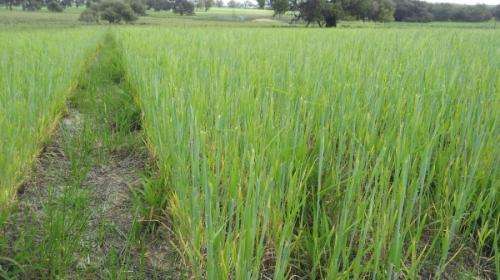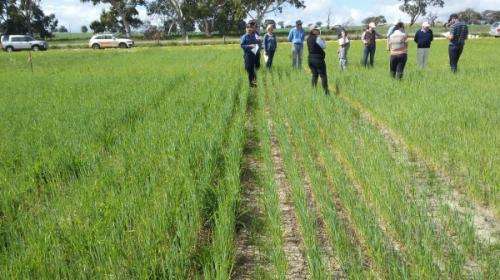Cropping research takes advantage of divergent growth patterns

Agricultural scientists are sowing winter grain crops such as wheat into established summer-growing perennial grasses to try and boost soil quality and improve water use while maintaining crop yields and summer grazing for stock.
The researchers are comparing simulated models of the novel pasture-cropping system against traditional monoculture (single) crop and pasture production farming methods.
CSIRO lead researcher Dean Thomas says traditional cropping methods utilise the Mediterranean-type climatic system of winter-spring rainfall but claims these methods under-utilise summer rains.
"The perennial grasses make use of summer rain hence the moisture and nutrients are stored and utilised within the system rather than being leached out of the soil," Dr Thomas says.
He says pasture cropping uses the divergent growth patterns of summer-active perennial grasses such as panic grass (Panicum maximum) and winter-active annual crops such as wheat, lupins and barley.
Summer grasses can then be used for stock grazing.
The research assessed climates most suited to pasture-cropping by simulating the different farming systems, monoculture, pasture production and pasture-cropping, across five Wheatbelt sites—Moora, Mingenew, Cunderdin, Karoonda and Jerdacuttup.
Each site was then planted with a winter grain crop which was sown into the established perennial grass and herbicide was sprayed onto the grass prior to seeding.
"This kept the perennial grass growth down during the grain crops winter growing season," Dr Thomas says.

"The grass stays dormant, using little water during times of high rainfall, and then grows opportunistically on left-over soil moisture and summer rain."
The researchers collated crop and pasture data using an Ausfarm computer simulation farming model which used daily weather data collected over the last fifty years and can predict the potential of pasture-cropping farm models.
"The biophysical farm trial sites were studied for five years but the computer simulator can predict outcomes for pasture cropping for the next fifty years," Dr Thomas says.
They assessed crop yield performance in terms of the yield effect in relation to pasture competition with the Moora and Jerdacuttup sites proving most suitable due to their climates.
"These areas tended to have enough winter rainfall and cold enough winter temperatures to reduce competition and grain yields were less affected," Dr Thomas says.
He says the local climate and rainfall during May and June were important drivers of successful pasture cropping systems.
The research found farmers should carefully consider local climates when planning the pasture cropping farming method.
More information: "Selection of crop cultivars suited to the location combined with astute management can reduce crop yield penalties in pasture cropping systems." Crop and Pasture Science 65(10) 1022-1032 dx.doi.org/10.1071/CP13436
Provided by Science Network WA















